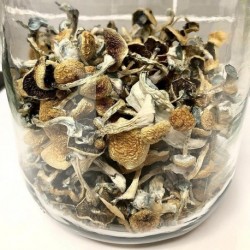The Genus Psilocybe includes more than 180 different species located in a wide variety of habitats. With the growing recognition of the medicinal properties of psilocybe, people are examining the genus more thoroughly. One species attracting attention due to its power and easy cultivation outdoors is Psilocybe azurescens. It is preferred to buy Psilocybe Azurescens online.
Psilocybe azurescens, a.k.a. Flying Saucer Mushroom
The most well-known of the Genus Psilocybe is Psilocybe cubensis (Earle), a tropical/subtropical species which often grows in cow dung. It has a long stem, a broad cap that is yellow/brown, and an annulus shaped like a skirt. Psilocybe cubensis are incredibly easy to grow and is widely promoted.
Psilocybe azurescens are usually called by a range of names, including Azzies, Astoriensis, Flying Saucers, Blue Runners, Blue Angels, or Indigo Psilocybe. They are distinguished by their caramel-colored caps, clear white stems, and broad umbo, Azurescens appear distinct when you “get your eye into.” For those with no training, many Psilocybes may look similar to other little black mushrooms hidden in the undergrowth. The most important thing is to be aware of the characteristics of the species you’re searching for, as well as the species you’re not. The species Galerina, for instance, are dangerous, while many other similar species could be poisonous.
What does Psilocybe Azurescens look like?
azurescens are closely connected to Psilocybe Cyescens, Psilocybe allenii, the Australian species Psilocybe subaeruginosa, as well as the New Zealand species Psilocybe weraroa. They appear closely like P. cyanescens as well as P. subaeruginosa.
Mushrooms are the reproduction part that a fungus produces. The inside of the cap is where those gills, where L. spores are produced and ejected into the air so that they can be dispersed via air circulation. By placing the cap onto paper or foil and leaving the gills open, the spore print can be made for the identification of spores or for growth.
The taxonomy of Psilocybe azurescens is classified as sporting a darker caramel-colored cap (pileus) which is 3 to 10 centimeters in width and conic to convex in shape and becoming flat with the passage of time, and with a broad umbo (the characteristic nipple-like). The cap’s surface is smooth, and it has the appearance of viscosity after being moist. It feels sticky to the touch. It also has an elongated gelatinous pellicle which can be removed if the cap is cut carefully. Caps are hygrophanous. As it dries, it alters color, turning yellow or dirty brown. The cap’s edge is usually smooth. Sometimes, it is the appearance of a light blue or azure shade. The cap that is azurescens does not rotate upwards in order to create the sine-wave border that P. Cyanescens is well-known for.
The stem (officially known as the stipe in reference to mushrooms) could be anywhere from nine centimeters or 20 centimeters in length and three millimeters up to six millimeters. The stem is typically transparent and white, but it can change into a dark grey or brown as it ages. The stem is made up of cartilaginous, thick, fibrous mycelium that resembles it. The stem’s base is thicker toward the ground and usually has large mycelium tufts that are white and white Rhizomorphs.
Young specimens are covered in an unveiled white veil that resembles cobwebs that cover the cap. This veil fades when the cap expands, with the edges of the cap having a temporary white edge. There is also an annular area at the top of the stem, which is usually covered with violet-brown spores.
A key characteristic of the Genus Psilocybe is blue-blue bruising. All components of Azurescens, including the gills, will bruise in a stark blue or indigo black when they are damaged. So, are you interested to buy psilocybe azurescens online?


















